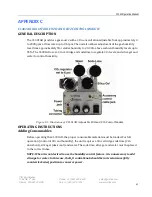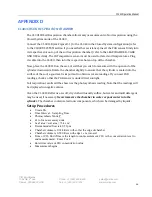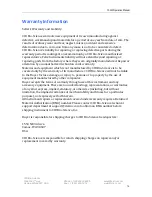
CI-340 Operation Manual
CID Bio-Science
1554 NE 3
rd
Ave
Camas, WA 98607, USA
Phone: +1 (360) 833-8835
Fax: +1 (360) 833-1914
sales@cid-inc.com
www.cid-inc.com
70
bag is lined up, and the two pieces connected, tighten the thumb screws making sure the bag is firmly in
position between the seals.
If the chosen method was to cut a hole in the side of a plastic bag, after the canopy chamber
attachment has been put on the bag, place the plant inside the bag. Close the open end of the bag by
twisting it tightly and wrapping a rubber band around it. Other methods work as well; just make sure
that the bag is air tight so that the system is closed.
Rigid Chamber Wall
For long term or laboratory studies, a rigid canopy chamber enclosure of glass or plastic may be
constructed. The same regulations apply as to using a plastic bag; a circular hole approximately 65 mm
needs to be cut on one side to allow the canopy chamber attachment to be properly installed. Typically,
a box type chamber is designed to be opened from the top or on a side where the user may reach the
“inside” canopy chamber attachment piece.
If a rigid chamber enclosure is made, an additional slot can be made for the PAR sensor on the
enclosure for accurate measurements of ambient light intensity. The “outside” canopy chamber
attachment piece has a position for the PAR sensor, but this position will not always provide reliable
measurements.
To prepare for measurements, align “inside” and “outside” canopy attachment pieces with the seals
facing the enclosure wall
.
With this alignment, the
tubes from the “outside” piece should slide into the
respective holes in the “inside” piece. Secure the entire canopy chamber attachment onto the enclosure
by tightening the thumbscrews on the “inside” piece.
Attaching Chamber to the CI-340
Once the “inside” and “outside” pieces are securely attached to the canopy chamber and the
chamber is sealed air-tight, attach the canopy chamber attachment to the CI-340 analyzer. Similar to
attaching leaf chambers, gently slide the exposed tubes on the “outside” at
tachment piece into the holes
on the CI-340 and tighten the locking screw on the CI-340. Place the IR Temperature sensor firmly into
the opening located on “outside” attachment piece. Plug the IR Temperature sensor connector into the
proper port on the CI-
340. Finally, insert the PAR sensor into the slot on the “outside” attachment piece
or in the specially made hole on the rigid enclosure wall. If the chamber enclosure is made of flexible
material, a tripod is suggested for appropriate support of the CI-340. The tripod should be positioned
after the canopy chamber attachment has been completely set up and attached to the CI-340 analyzer.
How to Measure:
After the canopy chamber is connected to the CI-340 analyzer, including connecting the IR
temperature sensor and PAR sensor, attach a tube connecting the intake and exhaust of the analyzer so
that the machine is set up for a close system measurement.
•
Turn on the device and wait for the normal power up sequence.
•
Enter the appropriate filename.
•
Enter an appropriate time interval in seconds.
•
When prompted to choose P, S, or C, select P allowing the analyzer to run in differential mode
(and later allows the user to select a closed system type measurement).
•
When using the canopy chamber attachment, typically no accessories are used, so select the
default of 0.
Summary of Contents for CI-340
Page 3: ......







































